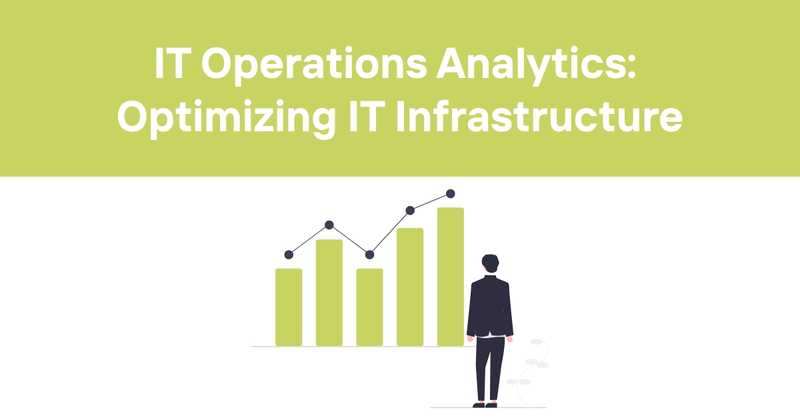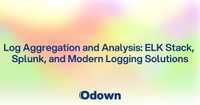IT Operations Analytics: Optimizing IT Infrastructure
IT operations analytics (ITOA) has become an indispensable tool for organizations looking to optimize their IT infrastructure and operations. By harnessing the power of data, ITOA enables IT teams to make informed decisions, improve system performance, and enhance the overall user experience. Let's dive into the world of IT operations analytics and explore how it's revolutionizing the way businesses manage their IT operations.
Table of Contents
- What is IT Operations Analytics?
- The Evolution of ITOA
- Key Components of ITOA
- ITOA vs. Observability
- ITOA Technologies and Tools
- The ITOA Process
- Key Performance Indicators (KPIs) for ITOA
- Benefits of Implementing ITOA
- Challenges in ITOA Implementation
- Best Practices for ITOA Success
- The Future of ITOA
- How Odown Supports ITOA Efforts
What is IT Operations Analytics?
IT operations analytics is a data-driven approach to managing and optimizing IT systems and processes. It involves collecting, storing, and analyzing vast amounts of data generated by IT infrastructure, applications, and services. The goal? To gain actionable insights that can improve operational efficiency, reduce downtime, and enhance the overall performance of IT systems.
I've seen firsthand how ITOA can transform IT departments from reactive firefighters to proactive problem-solvers. It's like giving your IT team a crystal ball – except this one's powered by data and algorithms instead of magic.
The Evolution of ITOA
ITOA didn't just appear out of thin air. It's the result of years of technological advancements and changing business needs. Let's take a quick trip down memory lane:
- Early 2000s: The rise of basic system monitoring tools
- Mid-2000s: Introduction of more sophisticated log analysis techniques
- Late 2000s: Emergence of big data technologies
- 2010s: Integration of machine learning and AI into IT operations
- Present day: Advanced ITOA platforms combining multiple data sources and analytics techniques
I remember when we used to rely solely on log files and basic monitoring tools. Now, we're dealing with complex algorithms and predictive analytics. It's like going from a magnifying glass to an electron microscope!
Key Components of ITOA
ITOA isn't just one thing – it's a combination of various components working together. Here are the main players:
- Data Collection: Gathering data from various sources like logs, metrics, and events
- Data Storage: Storing collected data efficiently for analysis
- Data Analysis: Applying algorithms and statistical methods to extract insights
- Visualization: Presenting data and insights in an easily digestible format
- Alerting and Reporting: Notifying relevant parties of important findings and generating reports
Each of these components plays a crucial role in the ITOA process. It's like a well-oiled machine – if one part isn't working properly, the whole system suffers.
ITOA vs. Observability
You might be wondering, "Isn't this just observability with a fancy name?" Well, not quite. While ITOA and observability share some common goals, they're not exactly the same thing. Let's break it down:
| Aspect | ITOA | Observability |
|---|---|---|
| Focus | Analyzing IT operations data for insights | Understanding system behavior through external outputs |
| Scope | Broader, includes business impact analysis | Primarily focused on technical aspects |
| Data Sources | Various IT and business data | Metrics, events, logs, and traces (MELT) |
| Primary Goal | Improve IT operations and business outcomes | Improve system reliability and performance |
| Typical Users | IT operations teams, business analysts | DevOps and SRE teams |
While there's certainly some overlap, ITOA tends to take a more holistic view of IT operations and their impact on the business. Observability, on the other hand, is more focused on the nitty-gritty of system behavior.
ITOA Technologies and Tools
ITOA relies on a variety of technologies and tools to get the job done. Here are some of the key players:
-
Log Analysis Tools: These help make sense of the mountains of log data generated by IT systems.
-
Application Performance Management (APM) Solutions: APM tools monitor and manage the performance of software applications.
-
Network Performance Monitoring Tools: These keep an eye on network traffic and performance.
-
Artificial Intelligence for IT Operations (AIOps) Platforms: AIOps tools use AI and machine learning to automate and enhance IT operations.
-
Business Intelligence (BI) Tools: BI solutions help analyze and visualize data for business insights.
-
Predictive Analytics Software: These tools use historical data to predict future trends and potential issues.
-
Event Correlation Engines: These help identify relationships between different events in IT systems.
I've used quite a few of these tools over the years, and let me tell you, they can be game-changers when implemented correctly. But they're not magic bullets – you still need skilled people to interpret the results and make decisions.
The ITOA Process
ITOA isn't just about throwing data at a problem and hoping for the best. It's a structured process that involves several key steps:
-
Data Collection: Gathering data from various sources across the IT infrastructure.
-
Data Integration: Combining data from different sources into a unified format.
-
Data Analysis: Applying analytical techniques to extract meaningful insights.
-
Pattern Recognition: Identifying trends and patterns in the data.
-
Anomaly Detection: Spotting unusual behavior that could indicate problems.
-
Predictive Analysis: Using historical data to forecast future trends and potential issues.
-
Visualization and Reporting: Presenting findings in an easily understandable format.
-
Action and Optimization: Using insights to make improvements and optimize operations.
This process isn't always linear – it's often iterative, with insights from one stage feeding back into earlier stages. It's like a feedback loop of continuous improvement.
Key Performance Indicators (KPIs) for ITOA
How do you know if your ITOA efforts are paying off? That's where KPIs come in. Here are some important ones to keep an eye on:
-
Mean Time to Detect (MTTD): How quickly can you identify issues?
-
Mean Time to Resolve (MTTR): How long does it take to fix problems once they're identified?
-
System Uptime: What percentage of time are your systems available and functioning correctly?
-
Resource Utilization: How efficiently are you using your IT resources?
-
Incident Frequency: How often do problems occur?
-
Cost per Incident: What's the average cost of resolving an issue?
-
User Satisfaction: How happy are your users with the IT services provided?
-
Predictive Accuracy: How accurate are your predictive models in forecasting issues?
These KPIs can give you a good sense of how well your ITOA implementation is performing. But remember, it's not just about the numbers – it's about the insights and improvements they lead to.
Benefits of Implementing ITOA
So, why should you care about ITOA? Well, let me count the ways:
-
Improved System Performance: By identifying bottlenecks and inefficiencies, ITOA can help you optimize your systems for better performance.
-
Reduced Downtime: Predictive analytics can help you spot potential issues before they cause outages.
-
Cost Savings: By optimizing resource usage and reducing incidents, ITOA can lead to significant cost savings.
-
Enhanced User Experience: Better performing, more reliable systems mean happier users.
-
Data-Driven Decision Making: ITOA provides the insights you need to make informed decisions about your IT operations.
-
Improved Compliance: Better visibility into your IT operations can help ensure you're meeting regulatory requirements.
-
Faster Problem Resolution: With better insights into your systems, you can resolve issues more quickly when they do occur.
I've seen organizations transform their IT operations through effective use of ITOA. It's not always an easy journey, but the benefits can be substantial.
Challenges in ITOA Implementation
Of course, implementing ITOA isn't all sunshine and rainbows. There are some challenges you'll need to overcome:
-
Data Quality Issues: Your insights are only as good as your data. Ensuring data quality can be a significant challenge.
-
Skills Gap: ITOA requires a unique blend of IT knowledge and data analysis skills. Finding or developing these skills can be difficult.
-
Tool Integration: Getting all your ITOA tools to play nicely together can be a headache.
-
Data Volume: The sheer amount of data generated by IT systems can be overwhelming.
-
Privacy and Security Concerns: With great data comes great responsibility. Ensuring the privacy and security of your data is crucial.
-
Resistance to Change: As with any new technology, you may face resistance from team members who are comfortable with the status quo.
-
Cost: Implementing ITOA can require significant upfront investment in tools and training.
Don't let these challenges discourage you, though. With proper planning and execution, they can be overcome.
Best Practices for ITOA Success
Want to make the most of your ITOA implementation? Here are some best practices to keep in mind:
-
Start with Clear Goals: Know what you want to achieve with ITOA before you start.
-
Focus on Data Quality: Ensure your data is accurate, complete, and relevant.
-
Invest in Training: Make sure your team has the skills they need to use ITOA effectively.
-
Choose the Right Tools: Select tools that fit your specific needs and integrate well with your existing systems.
-
Implement Gradually: Don't try to do everything at once. Start small and scale up as you gain experience.
-
Foster a Data-Driven Culture: Encourage your team to base decisions on data and insights.
-
Regularly Review and Adjust: ITOA is an ongoing process. Regularly review your approach and make adjustments as needed.
-
Don't Forget the Human Element: While data is important, don't ignore the expertise and intuition of your IT team.
I've found that following these practices can greatly increase your chances of ITOA success. But remember, every organization is different – what works for one might not work for another.
The Future of ITOA
So, where is ITOA headed? Based on current trends, here are some predictions:
-
Increased AI and Machine Learning Integration: AI and ML will play an even bigger role in analyzing data and predicting issues.
-
Greater Automation: More aspects of IT operations will be automated based on ITOA insights.
-
Edge Analytics: With the growth of edge computing, we'll see more analytics happening at the edge.
-
Real-Time Analytics: As processing power increases, we'll move closer to true real-time analytics.
-
Integration with Business Analytics: ITOA will become more closely integrated with broader business analytics.
-
Focus on User Experience: ITOA will increasingly be used to optimize the end-user experience.
-
Predictive IT: We'll move from reactive to predictive IT, addressing issues before they impact users.
The future of ITOA looks exciting, and I can't wait to see how it evolves.
How Odown Supports ITOA Efforts
While we've covered a lot of ground on ITOA, it's worth noting how tools like Odown can support these efforts. Odown, a website uptime and monitoring tool, plays a crucial role in the ITOA ecosystem.
Odown provides real-time monitoring for websites and APIs, which is essential for collecting the data needed for effective ITOA. Its uptime monitoring capabilities help IT teams quickly detect and respond to outages, directly impacting key ITOA metrics like MTTD and MTTR.
Furthermore, Odown's SSL certificate monitoring tool contributes to security-related aspects of ITOA. By alerting teams to upcoming certificate expirations, it helps prevent security-related downtime and maintains compliance – both key concerns in ITOA.
The public status pages offered by Odown also play a role in ITOA communication strategies. They provide a transparent way to share system status with users, which can improve user satisfaction – another important ITOA metric.
By providing these critical monitoring and communication tools, Odown supports organizations in their ITOA journey, helping them collect essential data, respond quickly to issues, and maintain transparency with users.
In conclusion, IT operations analytics is a powerful approach that can transform how organizations manage their IT infrastructure. While it comes with its challenges, the benefits – from improved system performance to cost savings – make it well worth the effort. As we move into an increasingly data-driven future, ITOA will only become more critical. And with tools like Odown supporting these efforts, organizations are well-equipped to navigate this exciting landscape.



